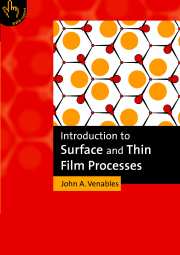Book contents
- Frontmatter
- Contents
- Preface
- Chapter 1 Introduction to surface processes
- Chapter 2 Surfaces in vacuum: ultra-high vacuum techniques and processes
- Chapter 3 Electron-based techniques for examining surface and thin film processes
- Chapter 4 Surface processes in adsorption
- Chapter 5 Surface processes in epitaxial growth
- Chapter 6 Electronic structure and emission processes at metallic surfaces
- Chapter 7 Semiconductor surfaces and interfaces
- Chapter 8 Surface processes in thin film devices
- Chapter 9 Postscript – where do we go from here?
- Appendix A Bibliography
- Appendix B List of acronyms
- Appendix C Units and conversion factors
- Appendix D Resources on the web or CD-ROM
- Appendix E Useful thermodynamic relationships
- Appendix F Conductances and pumping speeds, C and S
- Appendix G Materials for use in ultra-high vacuum
- Appendix H UHV component cleaning procedures
- Appendix J An outline of local density methods
- Appendix K An outline of tight binding models
- References
- Index
Chapter 1 - Introduction to surface processes
Published online by Cambridge University Press: 06 July 2010
- Frontmatter
- Contents
- Preface
- Chapter 1 Introduction to surface processes
- Chapter 2 Surfaces in vacuum: ultra-high vacuum techniques and processes
- Chapter 3 Electron-based techniques for examining surface and thin film processes
- Chapter 4 Surface processes in adsorption
- Chapter 5 Surface processes in epitaxial growth
- Chapter 6 Electronic structure and emission processes at metallic surfaces
- Chapter 7 Semiconductor surfaces and interfaces
- Chapter 8 Surface processes in thin film devices
- Chapter 9 Postscript – where do we go from here?
- Appendix A Bibliography
- Appendix B List of acronyms
- Appendix C Units and conversion factors
- Appendix D Resources on the web or CD-ROM
- Appendix E Useful thermodynamic relationships
- Appendix F Conductances and pumping speeds, C and S
- Appendix G Materials for use in ultra-high vacuum
- Appendix H UHV component cleaning procedures
- Appendix J An outline of local density methods
- Appendix K An outline of tight binding models
- References
- Index
Summary
In this opening chapter, section 1.1 introduces some of the thermodynamic ideas which are used to discuss small systems. In section 1.2 these ideas are developed in more detail for small crystals, both within the terrace–ledge–kink (TLK) model, and with examples taken from real materials. Section 1.3 explores important differences between thermodynamics and kinetics; the examples given are the vapor pressure (an equilibrium thermodynamic phenomenon) and ideas about crystal growth (a non-equilibrium phenomenon approachable via kinetic arguments); both discussions include the role of atomic vibrations.
Finally, in section 1.4 the ideas behind reconstruction of crystal surfaces are discussed, and section 1.5 introduces some concepts related to surface electronics. These sections provide groundwork for the chapters which follow. You may wish to come back to individual topics later; for example, although the thermodynamics of small crystals is studied here, we will not have covered many experimental examples, nor more than the simplest models. The reason is that not everyone will want to study this topic in detail. In addition to the material in the text, some topics which may be generally useful are covered in appendices.
Elementary thermodynamic ideas of surfaces
Thermodynamic potentials and the dividing surface
The idea that thermodynamic reasoning can be applied to surfaces was pioneered by the American scientist J.W. Gibbs in the 1870s and 1880s. This work has been assembled in his collected works (Gibbs 1928, 1961) and has been summarized in several books, listed in the further reading at the end of the chapter and in Appendix A.
Information
- Type
- Chapter
- Information
- Introduction to Surface and Thin Film Processes , pp. 1 - 35Publisher: Cambridge University PressPrint publication year: 2000
